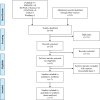Association of the WNT3 polymorphisms and non-syndromic cleft lip with or without cleft palate: evidence from a meta-analysis
- PMID: 30355643
- PMCID: PMC6250811
- DOI: 10.1042/BSR20181676
Association of the WNT3 polymorphisms and non-syndromic cleft lip with or without cleft palate: evidence from a meta-analysis
Abstract
Objective: This meta-analysis was conducted with the aim of investigating the association between WNT3 gene polymorphisms and non-syndromic cleft lip (CL) with or without cleft palate (NSCL/P) predisposition.
Methods: A comprehensive literature search was performed in six online databases including PubMed, Embase, ISI Web of Science, CENTRAL, CNKI, and Wanfang from inception up to June 2018 without language restriction. Pooled odds ratios (ORs) and corresponding 95% confidence intervals (95%CIs) were calculated under allele model of inheritance to indicate the association between WNT3 polymorphisms and NSCL/P. Risk of bias was assessed through the Newcastle-Ottawa scale (NOS). Predetermined stratified and sensitivity analyses were performed using the RevMan 5.3 software, publication bias were evaluated by Egger's and Begg's tests.
Results: Seven case-control studies comprising 1617 NSCL/P patients and 2143 healthy controls were identified and included in the present study, a total of eight loci were investigated in the present study: rs3809857 was significantly associated with NSCL/P vulnerability (G compared with T, OR = 1.34, 95%CI: 1.15-1.56, P=0.0001), a significant association between rs9890413 polymorphism and NSCL/P susceptibility (A compared with G, OR = 1.25, 95%CI: 1.06-1.47, P=0.007) was detected as well. Since only few studies reported detailed data about the association between rs142167, rs7207916, rs199498, rs111769, rs12452064, rs11653738, and NSCL/P risk, these results were not combined using meta-analysis.
Conclusion: Based on the findings of our current study, the rs3809857 and rs9890413 polymorphisms of WNT3 appeared to be associated with NSCL/P. Limited evidence is found to support the association between other WNT3 polymorphisms and risk of NSCL/P.
Keywords: meta analysis; non-syndromic cleft lip with or without cleft palate; polymorphism; wnt3.
© 2018 The Author(s).
Conflict of interest statement
The authors declare that there are no competing interests associated with the manuscript.
Figures








Similar articles
-
Variations in WNT3 gene are associated with incidence of non-syndromic cleft lip with or without cleft palate in a northeast Chinese population.Genet Mol Res. 2015 Oct 19;14(4):12646-53. doi: 10.4238/2015.October.19.8. Genet Mol Res. 2015. PMID: 26505415
-
Association of Betaine-Homocysteine S-Methyl Transferase (rs3797546 and rs3733890) polymorphisms with non-syndromic cleft lip/palate: A meta-analysis.Int Orthod. 2019 Dec;17(4):643-651. doi: 10.1016/j.ortho.2019.08.003. Epub 2019 Aug 23. Int Orthod. 2019. PMID: 31451344
-
Polymorphic Variants of V-Maf Musculoaponeurotic Fibrosarcoma Oncogene Homolog B (rs13041247 and rs11696257) and Risk of Non-Syndromic Cleft Lip/Palate: Systematic Review and Meta-Analysis.Int J Environ Res Public Health. 2019 Aug 5;16(15):2792. doi: 10.3390/ijerph16152792. Int J Environ Res Public Health. 2019. PMID: 31387249 Free PMC article.
-
Genotype and haplotype analysis of WNT genes in non-syndromic cleft lip with or without cleft palate.Eur J Oral Sci. 2012 Feb;120(1):1-8. doi: 10.1111/j.1600-0722.2011.00938.x. Eur J Oral Sci. 2012. PMID: 22288914
-
Association of WNT9B Gene Polymorphisms With Nonsyndromic Cleft Lip With or Without Cleft Palate in Brazilian Nuclear Families.Cleft Palate Craniofac J. 2015 Jan;52(1):44-8. doi: 10.1597/13-146. Cleft Palate Craniofac J. 2015. PMID: 24437584 Free PMC article.
Cited by
-
Single-Nucleotide Polymorphisms in WNT Genes in Patients with Non-Syndromic Orofacial Clefts in a Polish Population.Diagnostics (Basel). 2024 Jul 17;14(14):1537. doi: 10.3390/diagnostics14141537. Diagnostics (Basel). 2024. PMID: 39061674 Free PMC article.
-
Evidence Mapping and Quality Analysis of Systematic Reviews on Various Aspects Related to Cleft Lip and Palate.J Clin Med. 2023 Sep 16;12(18):6002. doi: 10.3390/jcm12186002. J Clin Med. 2023. PMID: 37762942 Free PMC article. Review.
References
Publication types
MeSH terms
Substances
LinkOut - more resources
Full Text Sources
Medical

